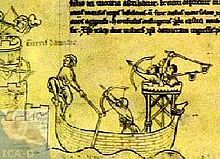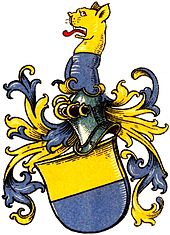Bernsau (noble family)
Bernsau is the name of an ancient Bergisch noble family, whose line of tribe goes back to the middle of the 12th century.
history
Initially Ministeriale of the Counts of Berg and Archbishops of Cologne , they provided the Electoral Cologne Truchsess with Gerhard von Bernsau from 1243 to 1261 . In the Limburg succession dispute , the Bernsau switched to the side of the city of Cologne . In 1348 they became feudal men of the Abbey of St. Michael near Siegburg, which had been in feud with the Counts of Berg for centuries.
The family lived in Bernsau Castle in the Agger lowlands in the north of today's city of Overath . In the first half of the 14th century it was built by the neighboring Großbernsau Castle , which sold it to the St. Michael Abbey in order to be enfeoffed with it.
In 1715 the noble line died out due to a lack of legitimate descendants with the death of the imperial and electoral Cologne general Heinrich Ferdinand Freiherr von Bernsau.
However, it was propagated through the two legally recognized pre- and post-marital sons of Wilhelm V (III.) Von Bernsau (1514–1572), Mr. zu Hardenberg and Mitherr zu Anger - starting with Reinhard Bernsau (approx. 1540-1615) , Judge and Rentmeister zu Hardenberg and Heinrich Bernsau (after 1550 – before 1618), Rentmeister zu Anger.
origin
The name Bärenau is also often mentioned . One invokes the legend of the daughter Jutta of Countess Gerita von der Burg Bensberg , who is said to have been kidnapped by a she-bear and was found undamaged in the Aggeraue next to the she-bear who was struck by lightning.


As Adolf III. von Berg (1193-1218) prepared in the spring of 1218 in Bensberg to take part in the Fifth Crusade , Adolphus de Bernsowe and Theodericus, his brother, were among his entourage. With another brother, Henricus de Bernsovle, Adolph joined his master on the journey to the Holy Land . On July 15, 1218, the two brothers and their cousin Remboldus de Bernsovle witnessed a gift from Adolf III during the siege of Damiette , the two brothers being the sons of Adolf (the elder) de Bernsovle (* around 1160; † before 1218) are listed. With the latter, the sequence begins.
At the end of August 1218 Damiette fell into the hands of the Crusaders. In 1222 and 1224 the three brothers appeared together in their homeland as witnesses in documents from the Archbishop of Cologne and - since his brother Adolf III. before Damiette died of an epidemic - Count von Berg Engelbert .
Adolf Bernsau, the crusader, became the master of Bernsau and propagated the family. His brother Heinrich de Bernshowe found himself in 1229 in the suite of Archbishop Heinrich of Cologne. The third brother, Theodoricus clericus de Bernsowe, entered the clergy.
In 1243, Adolf's son Gerhardus de Berensovle appears as a Truchsess Kurköln.
His four sons Ulrich, Adolf, Giselbert and Tilman von Bernsau acknowledged the payment to the city of Cologne on February 28, 1291 in a document bearing the Bernsau seal, which means that they are confessed to the archbishop in the battle of Worringen in 1288 for the city and received their pay for their feudal services.
Emmerich von Bernsau (1285/90 - after 1363) was enfeoffed with Großbernsau Castle in 1348 .
Emmerich's grandson Wilhelm I von Bernsau (1360/70 - after 1418) was in feud with the city of Cologne in 1411 .
coat of arms
The family coat of arms is divided by gold over blue. The seal of the knight Emberich von Bernsau from 1357 shows more of a shield head . On the helmet with a blue and gold helmet cover a growing male body, which is labeled like the shield and which, based on the gender name, also appears like a bear. The crest but was also drawn as a growing donkey hull.
The later variant of those from Bernsau zu Hardenberg (1529) shows a quartered shield: in fields 1 and 4 the family coat of arms, in fields 2 and 3 the (color-changed) coat of arms of the Westphalian von Hardenberg .
Name bearer
- Gerhard von Bernsau (around 1215–1249 / 50), Truchsess from the Cologne region
- Wilhelm II. Von Bernsau (1410 / 20–1489), 1444 participant in the Hubertus Battle near Linnich, knight of the Order of Hubert ⚭ a daughter of Wilhelm von Nesselrode († 1474), Herr zu Stein, bailiff of Windeck and Landdrost von Berg
- Margarethe von Bernsau, 1527 court master of the electoral princess of Saxony
- Wilhelm V (III.) Von Bernsau (1514–1572), Lord of Hardenberg, Bergischer Marshal
- Heinrich von Bernsau, 1593–1625 Commander of the Johanniterkommende Lage
- William VI. (IV.) Von Bernsau (1550–1595 / 96), Herr zu Hardenberg, Bergischer Marshal ⚭ Magdalena Countess von Daun-Falkenstein, sister of Count Wirich VI. by Daun-Falkenstein
- Wirich von Bernsau (1582–1656), Klevian statesman
- Johann Sigismund von Bernsau (1606 / 07–1655), Mr. Zu Hardenberg, converted to the Catholic Church in 1649 ⚭ 1633/34 Anna von Asbeck (1590–1685), called the Franciscans to Neviges in 1676, in 1680 an image of Mary was brought to Neviges, which the Nevigeser pilgrimage justified
- Agnes Elisabeth von Bernsau († 1675) ⚭ Jakob von Rottkirchen († 1676), 1665/1675 mayor of Cologne
- Margarethe Gertrud von Bernsau († 1702) ⚭ Franz Caspar Adrian Graf Schellart von Obbendorf (1628–1701), imperial chamberlain, field marshal, envoy and governor of Düsseldorf, bailiff of Gladbach and Grevenbroich, lord of Müggenhausen, Iversheim, Grempten, Rhunen, Bellinghoven ; After it had been rejected in Düsseldorf, Count Schellart forced the marriage of different denominations in the Bernsauze area in Homberg by appearing with the heavily armed electoral bodyguard in front of Pastor Gottfried Peill's house and threatening Peill and the whole community in the most serious way
- Heinrich Ferdinand Freiherr von Bernsau and Schönheim († 1715), Elector of Cologne General Car Master, Imperial General Field Sergeant (Lieutenant General)
- Johannes Bernsau (1675–1750), Mayor of Elberfeld
- Katharina Helena Bernsau (1710–1792) ⚭ Johann Heinrich Maurenbrecher (1691–1753), Kurpfälzischer Kommerzienrat, postmaster and wine merchant
literature
- Leo van de Loo, Bernsau. On the history of the knight and peasant family (1150–1940) , Essen 1940
- Kurt Niederau : On the history of the Bergisch nobility; that of Bernsau from the 14th to 16th centuries. In: Journal of the Bergisches Geschichtsverein, 82nd Bd., Neustadt ad Aisch 1966, pp. 98–201.
- Leo Peters: An addendum: An invitation to the marriage of Heinrich von Bernsau in 1589. In: Zeitschrift des Bergisches Geschichtsverein, 91st Bd., Neustadt ad Aisch 1985, pp. 271-272.
Individual evidence
- ↑ Thomas Bohn, Countess Mechthild von Sayn (1200/03 - 1285) , Cologne and Weimar 2002, p. 678
- ↑ Willi Fritzen: The former Alt-Bernsau Castle, manor of the Knights of Bernsau (12th century)
- ↑ Bernhard Peter: Wappensammlung (13) Middle Rhine and Moselle
- ↑ Overath - history of the community, cf. Willi Fritzen: The former Alt-Bernsau Castle, manor of the Knights of Bernsau (12th century)
- ^ Book of arms of the Westphalian nobility (Book 2): Plate 25
- ↑ Johannes Abresch, From the life of the Bergisch pastor Gottfried Peill , monthly for Protestant Church History of the Rhineland 55 (2006), pp. 307–326
